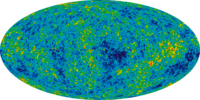
Photo from wikipedia
We propose a novel class of compact dark matter objects in theories where the dark matter consists of multiple sectors. We call these objects $N$-MACHOs. In such theories neither the… Click to show full abstract
We propose a novel class of compact dark matter objects in theories where the dark matter consists of multiple sectors. We call these objects $N$-MACHOs. In such theories neither the existence of dark matter species nor their extremely weak coupling to the observable sector represent additional hypotheses but instead are imposed by the solution to the Hierarchy Problem and unitarity. The crucial point is that particles from the same sector have nontrivial interactions but interact only gravitationally otherwise. As a consequence, the pressure that counteracts the gravitational collapse is reduced while the gravitational force remains the same. This results in collapsed structures much lighter and smaller as compared to the ordinary single-sector case. We apply this phenomenon to a dark matter theory that consists of $N$ dilute copies of the Standard Model. The solutions do not rely on an exotic stabilization mechanism, but rather use the same well-understood properties as known stellar structures. This framework also gives rise to new microscopic superheavy structures, for example with mass ${10}^{8}\text{ }\text{ }\mathrm{g}$ and size ${10}^{\ensuremath{-}13}\text{ }\text{ }\mathrm{cm}$. By confronting the resulting objects with observational constraints, we find that, due to a huge suppression factor entering the mass spectrum, these objects evade the strongest constrained region of the parameter space. Finally, we discuss possible formation scenarios of $N$-MACHOs. We argue that, due to the efficient dissipation of energy on small scales, high-density regions such as ultracompact minihalos could serve as formation sites of $N$-MACHOs.
Journal Title: Physical Review D
Year Published: 2020
Link to full text (if available)
Share on Social Media: Sign Up to like & get
recommendations!